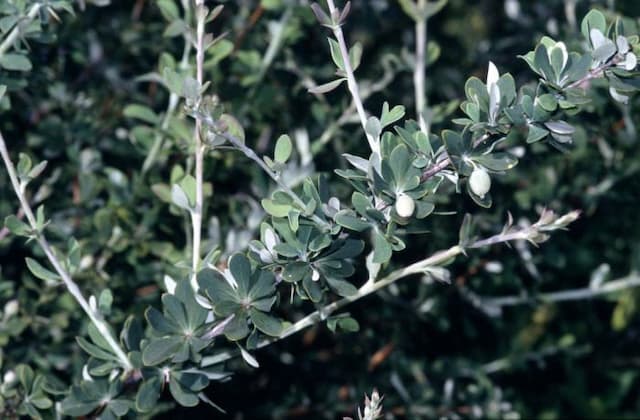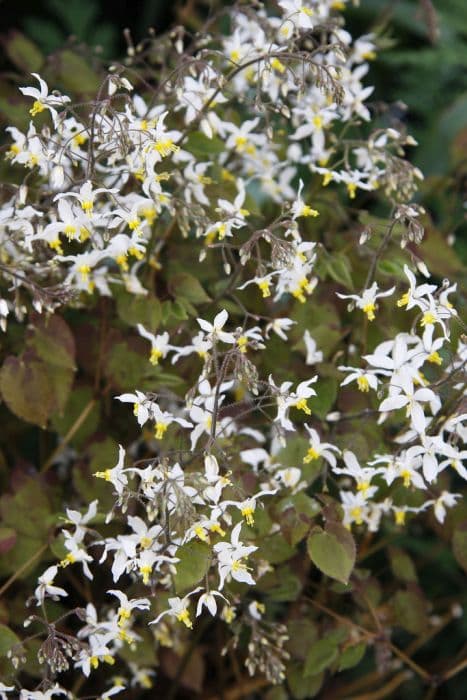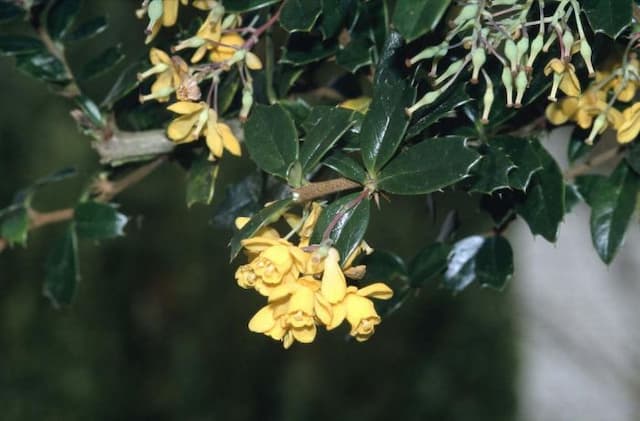Leatherleaf Mahonia Mahonia bealei

ABOUT
Commonly known as leatherleaf mahonia, this plant boasts a distinctive appearance with its large, pinnate leaves that resemble holly due to their spiny edges, but the leaves are a shade of blue-green that sometimes turns purple or red in the winter. The leaves grow in whorls of clusters, giving the impression of a layered, herringbone pattern which is quite striking in any garden setting. During late winter and early spring, the plant produces bright yellow flowers that cluster on erect racemes, which resemble small grape clusters. These inflorescences stand out against the dark foliage and attract various pollinators. As the seasons progress, the flowers develop into blue-black berries, providing a food source for birds and a visual interest for onlookers. The overall look of leatherleaf mahonia is somewhat architectural, with a textured, almost prehistoric appearance that makes it a focal point in landscapes favoring bold, structural plants.
About this plant
 Names
NamesFamily
Berberidaceae
Synonyms
Leatherleaf Mahonia, Beale's Barberry, Beale's Mahonia
Common names
Berberis bealei Fortune, Mahonia japonica var. bealei (Fortune) Rehder.
 Toxicity
ToxicityTo humans
Leatherleaf Mahonia is considered to have a low level of toxicity to humans. While it's not commonly ingested, the berries can cause mild gastrointestinal symptoms if eaten in large quantities. Symptoms of poisoning may include nausea, vomiting, diarrhea, and stomach cramps. Care should be taken to prevent children from consuming the berries of Leatherleaf Mahonia.
To pets
Leatherleaf Mahonia can also be considered toxic to pets, such as dogs and cats, although the level of toxicity is generally low. If pets ingest parts of this plant, particularly the berries, they may exhibit symptoms such as vomiting, diarrhea, and general gastrointestinal distress. Pet owners should discourage their animals from eating any part of the Leatherleaf Mahonia to prevent potential poisoning.
 Characteristics
CharacteristicsLife cycle
Perennials
Foliage type
Evergreen
Color of leaves
Blue-green
Flower color
Yellow
Height
4-6 feet (1.2-1.8 meters)
Spread
5 feet (1.5 meters)
Plant type
Shrub
Hardiness zones
6
Native area
China
Benefits
 General Benefits
General Benefits- Landscape Aesthetics: Mahonia bealei, commonly known as leatherleaf mahonia, adds visual interest to gardens with its spiny, holly-like evergreen leaves and its striking yellow flowers that bloom in late winter or early spring.
- Wildlife Support: The plant provides nectar for pollinators when not many other plants are in bloom, and its blue-black berries are a food source for birds and small mammals.
- Erosion Control: Leatherleaf mahonia's deep and extensive root system can help stabilize soil on slopes or in areas prone to erosion.
- Shade Tolerance: This plant can thrive in part to full shade conditions, making it an ideal choice for understory plantings or shaded garden spots.
- Drought Tolerance: Once established, leatherleaf mahonia is quite drought tolerant, reducing the need for frequent watering and making it suitable for xeriscaping or in regions with water scarcity.
- Year-Round Interest: With evergreen foliage, winter blooms, and colorful berries, leatherleaf mahonia offers visual interest in the landscape throughout all seasons.
- Privacy Screen: When planted in groups, the dense growth habit of leatherleaf mahonia can provide a natural privacy screen or hedge.
- Minimal Maintenance: Aside from occasional pruning to shape or remove dead wood, leatherleaf mahonia requires little maintenance, making it an easy-to-care-for addition to the landscape.
 Medical Properties
Medical Properties- Antibacterial: Mahonia bealei contains berberine, a compound known for its antibacterial properties.
- Antifungal: Berberine and other alkaloids in Mahonia bealei exhibit activity against fungal pathogens.
- Anti-inflammatory: The plant has compounds that may help reduce inflammation in the body.
- Antioxidant: Extracts from Mahonia bealei show antioxidant activity, helping to neutralize harmful free radicals.
 Air-purifying Qualities
Air-purifying QualitiesThis plant is not specifically known for air purifying qualities.
 Other Uses
Other Uses- Mahonia bealei can be used as a natural dye source, with the berries producing a purple dye, and the bark yielding a yellow dye suitable for fabrics and crafts.
- The wood of the Leatherleaf Mahonia is hard and can be used in small woodworking projects or for making tool handles due to its fine texture and durability.
- Landscapers implement the Leatherleaf Mahonia as a barrier plant because of its spiny leaves, creating a natural deterrent against animals and intruders.
- The flowers of Leatherleaf Mahonia provide nectar for bees early in the season, which is crucial as an early food source for pollinators when other flowers are scarce.
- The berries of the plant are sometimes used in making jellies and jams, though they require a significant amount of sugar due to their tartness.
- Leatherleaf Mahonia can be used in creating shelter belts or windbreaks in gardens, helping to protect more delicate plants from strong winds.
- The berries serve as food for various species of birds during the winter months, providing a valuable source of nutrition when other sources are depleted.
- Landscape designers use Leatherleaf Mahonia in sensory gardens for its interesting texture and fragrant blossoms that appeal to touch and smell.
- The ornamental appeal of this shrub makes it suitable for use in flower arrangements, where its foliage adds a unique contrast to other plants.
- Due to its evergreen nature and tolerance of low-light conditions, it is utilized in urban landscaping to green up spaces underneath trees or in shady corners of buildings.
Interesting Facts
 Feng Shui
Feng ShuiThe Leatherleaf Mahonia is not used in Feng Shui practice.
 Zodiac Sign Compitability
Zodiac Sign CompitabilityThe Leatherleaf Mahonia is not used in astrology practice.
 Plant Symbolism
Plant Symbolism- Protection: Mahonia bealei, commonly known as Leatherleaf Mahonia, features sharp, spiny leaves reminiscent of holly. These can symbolize protection and defense, hinting at the idea of safeguarding oneself or one’s home from negative forces.
- Tenacity: The Leatherleaf Mahonia is hardy and resilient, often thriving in difficult growing conditions. As such, it can represent the ability to persevere and remain strong in the face of adversity.
- Healing: Leatherleaf Mahonia has been used in traditional medicine, and its bright yellow flowers, which bloom even in the cold of winter, are associated with healing. This symbolism is often used to convey recovery or the presence of a nurturing influence during tough times.
- Beauty: Despite its tough exterior, the Leatherleaf Mahonia produces beautiful yellow flowers, symbolizing the concept that beauty can be found in unexpected places and can flourish against the odds.
 Water
WaterLeatherleaf Mahonia should be watered deeply and infrequently to encourage a strong root system. Water the plant once a week with about one to two gallons of water, adjusting for rainfall, less during winter months when the plant is dormant. It’s important not to overwater, as this can lead to root rot. During extreme drought, you might need to water twice a week, but always check the soil moisture before adding water.
 Light
LightLeatherleaf Mahonia thrives in partial to full shade conditions. The ideal spot for this plant is under the canopy of tall trees where it receives dappled sunlight or in an area that gets morning sun and afternoon shade. Avoid exposure to intense, direct sunlight, especially in the peak of summer, to prevent leaf scorch.
 Temperature
TemperatureLeatherleaf Mahonia prefers a temperature range between 60°F and 70°F but can withstand temperatures as low as 0°F in the winter and as high as 95°F in the summer. The plant is hardy and can survive occasional temperature fluctuations outside of its ideal range, but prolonged exposure to extremes can be harmful.
 Pruning
PruningLeatherleaf Mahonia should be pruned to remove dead or damaged wood and to shape the plant. The best time to prune is in late winter or early spring before new growth starts. Prune selectively, cutting back shoots that have flowered to promote new growth and maintain a compact form. It is not necessary to prune every year.
 Cleaning
CleaningAs needed
 Soil
SoilLeatherleaf Mahonia prefers a well-draining, slightly acidic soil mix with a pH of around 5.5 to 6.5. A mix of loamy garden soil, compost, and perlite or pine bark will provide the organic matter and drainage needed.
 Repotting
RepottingLeatherleaf Mahonia does not require frequent repotting; it can be repotted every 2 to 3 years or when it outgrows its current container.
 Humidity & Misting
Humidity & MistingLeatherleaf Mahonia thrives in moderate to high humidity levels but is generally tolerant of average household humidity.
 Suitable locations
Suitable locationsIndoor
Keep in bright, indirect light and away from dry heat sources.
Outdoor
Plant in partial shade and shelter from strong winds.
Hardiness zone
6-9 USDA
 Life cycle
Life cycleMahonia bealei, commonly known as leatherleaf mahonia, typically begins its life cycle as a seed, which after stratification (a period of cold treatment to break dormancy) germinates in the spring. The seedling emerges and develops compound leaves with spiny leaflets, characteristic of the species. It grows into a sturdy evergreen shrub, which can take several years to reach mature size. During late winter and early spring, the plant produces fragrant yellow flowers in dense, upright racemes, which are pollinated by insects, leading to the formation of blue-black berries by late summer or early fall. These berries are consumed by birds, which then disperse the seeds, completing the cycle of reproduction. This plant can also spread vegetatively through rhizomes, thereby expanding its presence in suitable environments.
 Propogation
PropogationPropogation time
Late winter to early spring
Propogation: The most popular method of propagating Leatherleaf Mahonia, Mahonia bealei, is through seed collection and sowing. Optimal propagation time is usually in the fall after the berries have ripened. To propagate, collect the ripe berries, clean them, and sow the seeds in a well-drained mix of soil, ideally with some sand incorporated to ease root development. The seeds should be planted about a quarter inch deep. It's important to keep the soil moist but not waterlogged, to ensure the best germination conditions. Germination can be slow and may take several months; patience is key. Once seedlings have developed sufficiently, they can be transplanted outdoors into their permanent locations.









